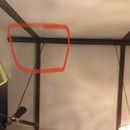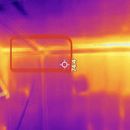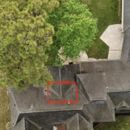Cathedral Ceiling Summer Condensation Mystery
Hello
My cathedral ceiling the other suddenly started accumulating water and was running down the ceiling in one spot.
I live in Houston TX and the outdoor temperature that day was 82-97°
The indoor temp was 70° downstairs and 71° upstairs.
humidity on the first floor was 55% , 68% at the peak of the 20ft ceiling and >90% in the attic.
I pulled away the insulation from the drywall in the attic and didn’t see any moisture on the top side.
There is a ceiling fan pulling air downward right where the issue occurred.
A few days later i used a FLIR camera to view the ceiling and where the condensation was is the coolest spot…. Which makes no sense as there are no ducts above this area.
How is this spot ~3° cooler in the cathedral ceiling than the surrounding parts. This is the measurement from a few days after the issue started and stopped.
Thanks
in the attached pics. The red box is where the condensation happened. The yellow box is the attic walkway.
GBA Detail Library
A collection of one thousand construction details organized by climate and house part













Replies
> How is this spot ~3° cooler
Evaporation causes cooling.
I suspect infiltration from above. Infiltration will cause condensation as warm/moist attic air is cooled to your chilly 71°.
Some things to try:
Air seal that area better
Run the ceiling fan blowing upward
Don't run exhaust fans (eg, kitchen or bathroom)
Increase interior temperature
Check that there are no roof leaks
Air seal any ducts in the attic
Create slightly positive building pressure or slightly negative attic pressure
Somehow reduce vapor diffusion from the attic into the ceiling
https://www.buildingscience.com/file/5864
Thanks for the commentary Jon
I have ordered a few tanks of closed cell foam to isolate the attic from the cathedral ceiling.
I have ridge vents on my roof but very few soffit vents. I was going to add a few more soffit vents but that would hinder me correct? How does one go about increasing the building pressure?
Thanks.
The A/C system could be rebalanced to ensure a slight positive pressure. Or just meticulously air seal any supply ducts in unconditioned spaces, while being a little less meticulous about return ducts.
Or you could install a very small supply-only ventilation system.
Or you could install an ERV ventilation system, balanced to provide a little positive pressure.
The first step in changing interior/attic pressure would be to measure it. The device I have is no longer available, so maybe someone has a recommendation for one.
Few soffit vents should help reduce attic pressure.
Do you have an air conditioning duct in the general area of that cold spot? Air likes to follow along smooth surfaces (a sort of laminar flow), so a nearby vent might be cooling that spot on the ceiling more than you'd expect. A simple baffle or other diverter would fix that, you just need to stir the air (turbulent flow) so that it gets diffused enough that it doesn't excessively cool any one spot.
I agree with Jon that air sealing is another big suspect here. You could potentially have a leaky duct that is pressurizing the cool part of that wall, for example.
Bill
Bill
I have ordered a few tanks of closed cell foam insulation to isolate the attic from the affected area.
I’m about to reroof my home and part of the ceiling doesn’t have a ridge vent but does have soffit vents, should i add a ridge vent?
Thanks for the feedback.
Spray foam might not be the best solution. I don't understand the layout your attic and ceiling and where you are planning to use the foam but my concerns include:
* Spray foam need to be applied properly to cure; if it doesn't you can get persistent odors. A DIY kit can be hit or miss. Problems are rare, but really bad when they occur.
* The blowing agents in the DIY kits are extremely potent greenhouse gases; more than 1000X worse than CO2.
Jake,
You might want to read this article: "Summertime Condensation Near the Peak of a Cathedral Ceiling."